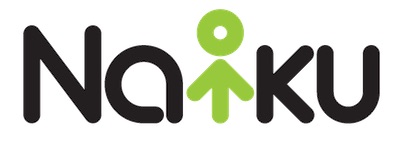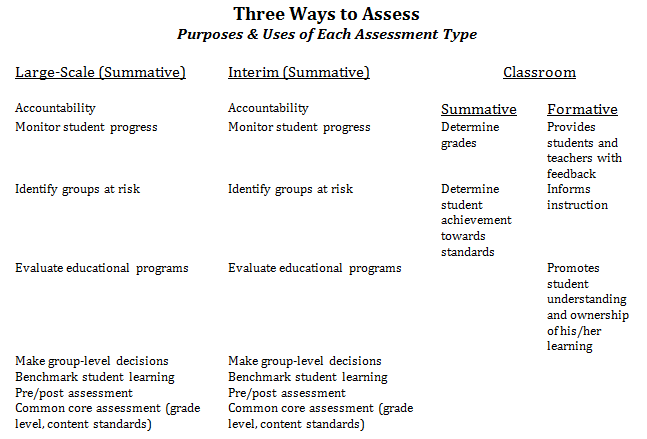Creating, Implementing, and Sustaining Effective Assessment Practices
As a society, we’ve shifted the thinking about schools from places where it’s OK for some students to succeed and some to fail to places where the expectation is for all students to succeed.
With this shift, the role of assessment has changed from separating successful and unsuccessful students to becoming a set of educational practices that support the learning of all students (Stiggins, 2008).
What are these assessment practices and how can they be used to most effectively support learning?
In the broadest sense, assessment is a means for gathering information about what students know—from large-scale, annual summative assessments to interim summative assessment to classroom-based, summative and formative assessment (see table below for assessment purposes and use).
Each of these three ways of assessment gives us a different, yet vital, view of student learning. And in the best of all worlds, we would engage each to improve our educational decisions, enhance instruction, and advance student learning.
How do we best understand what each student knows?
In the graphic below, the closer we get to the student, the more we know about the specifics of what that particular student knows. Yet, as educators, we can be most effective when we balance the use of all assessment information in order to improve our practices and to advance student learning.
 “Truly productive assessment systems within schools and districts serve the information needs of a wide variety of important assessment users. In other words, such systems acknowledge that a wide variety of decision makers need access to different kinds of information in different forms at different times to help student learn (Stiggins, 2008).”
“Truly productive assessment systems within schools and districts serve the information needs of a wide variety of important assessment users. In other words, such systems acknowledge that a wide variety of decision makers need access to different kinds of information in different forms at different times to help student learn (Stiggins, 2008).”
It’s this system and process of balancing assessment information that creates the richest and most useful information for educators, parents/community stakeholders, and students—each with different needs for and uses of assessment information.
In terms of creating and sustaining an effective balanced assessment system, two important questions arise:
- What essential conditions need to be in place in districts and schools to successfully establish an effective balanced assessment system?
- What training and support will educators need in order to implement and sustain this balanced assessment system?
First, changing assessment-related practices will not happen overnight. For educational practice to change and for these changes to “stick,” to gain traction, several conditions must be in place:
Educators must first see the benefit(s) of any change;
- Educators must be provided support and training specifically focused on improving student learning;
- This support and training must be job-embedded and explicitly linked to every day practice;
- Educators must be involved in site-based, collaborative learning teams focused on engaging in collegial feedback, implementing specific educational practices related to improving student learning, and engaging in intentional reflection on and adjustment of those practices; and
- Schools must be learning communities for educators and students, communities with a deeply embedded culture of learning.
Now the questions becomes, “What training and support will educators need in order to create and sustain a balanced assessment system?”
It is crucial to understand that district and school professional development and training need to be ongoing and job-embedded. A workshop or series of workshops won’t be effective in the long run.
In order to build and sustain an effective district- and schoolwide balanced assessment system, training and professional development need to be focused on several core educational practices that, together, provide a comprehensive and unremitting network of support for educators:
- Purposeful Collaboration: Maintaining successful collaboration between schools, districts, and the broader community
- Ongoing and Job-embedded Professional Development: Creating a school-and district-wide learning culture through learning communities
- Instructional Leadership: Building capacity in lesson design, implementation, assessment, and interventions
- Intentional Assessment Practices: Understanding and using assessment (both formative and summative) for advancing student learning and improving instructional practices
- Shared Leadership: Building capacity for administrators, teachers, and community stakeholders to work together to improve their effectiveness individually and collectively
- Standards-based Curriculum, Instruction, and Assessment: Aligning curriculum, instruction, and assessment to content standards
- School Culture: Developing positive relationships, student behavior, and collaborative culture in school
- Understanding and Using Data: Analyzing and using data to inform instruction and more closely meet students learning needs
- Working with and Involving External Stakeholders: Building family and community connections
- The Formative Assessment Process: Embedding effective formative assessment into classroom instructional practices and engaging students as proprietors of their own learning
It is this network, this web, of support that is critical in making success happen. In this sense, success is a verb, and parents, educators, and students can, with support and common purpose, create it together.
References
Stiggins, R. (2008). A Call for the Development of Balanced Assessment Systems, Assessment Training Institute, Portland, OR.


